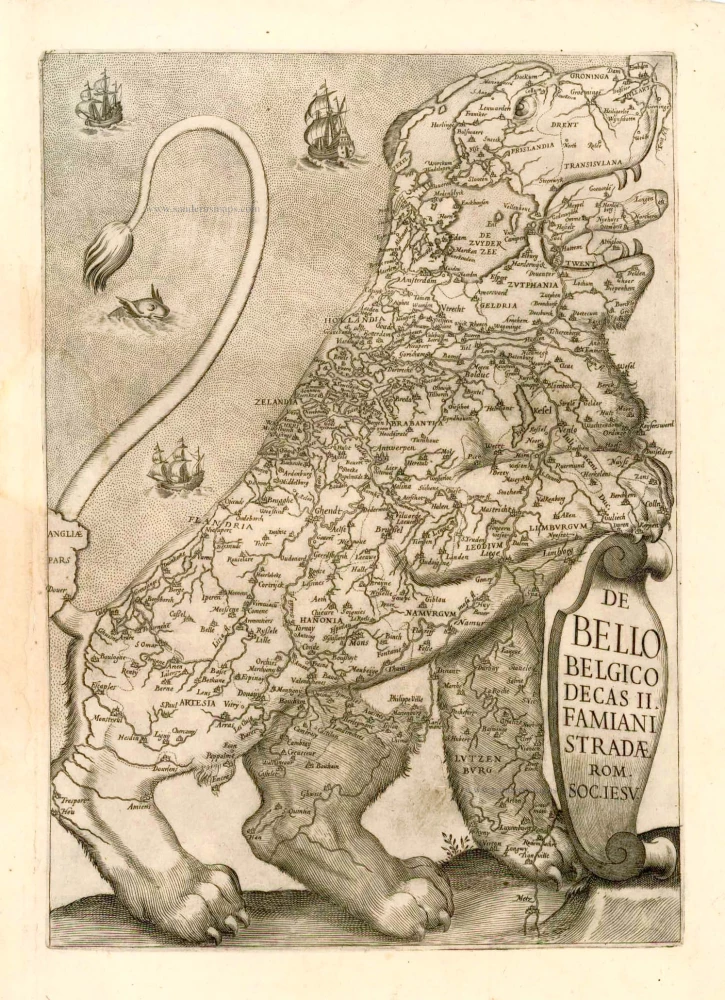Leo Belgicus, by Famiano Strada. 1647
Famiano Strada (Rome, 1572 – 1649)
Famiano Strada was a Jesuit priest who taught at the Collegio Romana of the Jesuits in Rome.
The most famous work by Famiano Strada is De Bello Belgico decades duae, 1555-1590. The book described the first period of the Eighty Years' War and was written with Alexander Farnese's help (1545-1592), around 1602. It provides a pro-Spanish and pro-Catholic account of the Dutch War of Independence. The first part, Decas Prima, was published in 1632 and the second part, Decas Secunda, in 1647.
Eight different copperplates of the Leo Belgicus were engraved in different sizes for Strada's book, all of them representing the lion rampant and facing right. The lion map served as an engraved frontispiece for both the first and the second decades. Editions in Italian, Dutch, French, Spanish and Polish language followed, but only the Latin and Dutch editions have de lion maps.
Leo Belgicus
The Netherlands, depicted in the form of a lion originated with the Austrian Michael von Aitzing (c. 1530-98), who inserted in his book De Leone Belgico (1583) a Leo Belgicus map, engraved by Frans Hogenberg. In the preface of this work, von Aitzing explains why he chose this particular title. He explains that Caesar mentioned in his "Commentaries" that the 'Belgae' were the strongest tribes, and he therefore decided - partly because of the religious conflicts in the war against Spain - to introduce the Netherlands in the shape of a lion.
De Bello Belgico Decas II.
Item Number: 27857 Authenticity Guarantee
Category: Antique maps > Europe > The Netherlands
Old, antique map - Leo Belgicus, by Famiano Strada.
Title: De Bello Belgico Decas II.
Famiani Stradae Rom. Soc. Iesu.
Date of the first edition: 1632.
Date of this map: 1647.
Copper engraving, printed on paper.
Size (not including margins): 315 x 220mm (12.4 x 8.66 inches).
Verso: Blank.
Condition: Light waterstained.
Condition Rating: A+.
References: Van der Heijden (Leo Belg), 7.2
From: Famiani Stradae Romani E Societate Iesu De Bello Belgico Decas Secunda. Romae: Ex typographia Haeredum Francisci Corbelletti, 1647.
Famiano Strada (Rome, 1572 – 1649)
Famiano Strada was a Jesuit priest who taught at the Collegio Romana of the Jesuits in Rome.
The most famous work by Famiano Strada is De Bello Belgico decades duae, 1555-1590. The book described the first period of the Eighty Years' War and was written with Alexander Farnese's help (1545-1592), around 1602. It provides a pro-Spanish and pro-Catholic account of the Dutch War of Independence. The first part, Decas Prima, was published in 1632 and the second part, Decas Secunda, in 1647.
Eight different copperplates of the Leo Belgicus were engraved in different sizes for Strada's book, all of them representing the lion rampant and facing right. The lion map served as an engraved frontispiece for both the first and the second decades. Editions in Italian, Dutch, French, Spanish and Polish language followed, but only the Latin and Dutch editions have de lion maps.
Leo Belgicus
The Netherlands, depicted in the form of a lion originated with the Austrian Michael von Aitzing (c. 1530-98), who inserted in his book De Leone Belgico (1583) a Leo Belgicus map, engraved by Frans Hogenberg. In the preface of this work, von Aitzing explains why he chose this particular title. He explains that Caesar mentioned in his "Commentaries" that the 'Belgae' were the strongest tribes, and he therefore decided - partly because of the religious conflicts in the war against Spain - to introduce the Netherlands in the shape of a lion.

